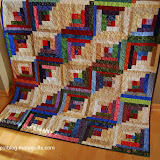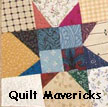I went looking for my first quilt book to see if they had a section on hand piecing hexagons -- unfortunately I couldn't find the book which is really frustrating! I'm going to have to keep looking for it.
 I'd ordered the Hexagon die for my GO Cutter and wanted to see if I could hand piece hexagon flowers with a goal of creating my own Grandmother's Flower Garden quilt. I've done these flowers by English Paper Piecing before but I know it will be much quicker to just learn to hand piece them.
I'd ordered the Hexagon die for my GO Cutter and wanted to see if I could hand piece hexagon flowers with a goal of creating my own Grandmother's Flower Garden quilt. I've done these flowers by English Paper Piecing before but I know it will be much quicker to just learn to hand piece them.I did find a few photos in one of my other books that showed me how to turn the corners so I made a test block. It's not too bad but if you enlarge the photo you'll see one corner is messed up but the others all look pretty good.
 Once the block was pieced, I wasn't sure how to press so I let the seams go the way they wanted to go.
Once the block was pieced, I wasn't sure how to press so I let the seams go the way they wanted to go. The only other quilt I've hand pieced is my first one. I'd never used a sewing machine and decided I'd hand piece it and then flew from my home in Florida to visit Deb in Virginia and she showed me how to use her machine and quilt it in straight lines. The binding was also sewn by machine. I came home from that trip and bought myself a very basic Singer sewing machine from Walmart which I used for the first year and a half I was quilting.
The only other quilt I've hand pieced is my first one. I'd never used a sewing machine and decided I'd hand piece it and then flew from my home in Florida to visit Deb in Virginia and she showed me how to use her machine and quilt it in straight lines. The binding was also sewn by machine. I came home from that trip and bought myself a very basic Singer sewing machine from Walmart which I used for the first year and a half I was quilting. 











12 comments:
The way I was taught was to use two templates - one to cut out the fabric and the other the "finished size" to mark the finished point on the wrong side of the fabric. That finished point is where you end your stitching. When you press the block have the seams all going the same way for the outer hexes like a Lemoyne star) and either make all the center hexes go in or out.
Hope this makes sense!
I did a mini tutorial on hand piecing hexagons with a running stitch and pressing them on my blog about a year ago. It's at http://quiltobsession.blogspot.com/2008/08/stitching-hexagon-flowers.html
I found Jinny Beyer's hand piecing book very helpful. I made my first quilt by hand, too -- from start to finish -- only stitched the binding on by machine and stitched down by hand, but hand quilted and hand appliqued a couple of the blocks. Marking the blocks takes a lot of time. Jinny Beyer eyeballs the 1/4 inch line, so doesn't need to mark the stitching lines.
Hi Mary, Jinny Beyer's book is great. I have made GFG quilts all by hand, and I never piece my blocks from the center out, I piece them into strips, then join the rows. I can make a two round flower plus the center in about 20 minutes by hand. I join them into long rows, then add the hexies between, and another row. Much easier to do vertical rows when piecing the top together.
My ninth GFG was all pieced by machine using the same method I use to piece them by hand. I never press my GFG quilts. I find that when handquilting its nice to be able to move the seam with the needle is so desired. They are addictive, and I don't think I would ever do it I had to English piece them.
Jay
Mary,
The first big quilt I did was GFG. I learned as I went. Best tip I have is to mark the hexagons at the points so that you know where to stop stitching. It sounds tedious, but that way I could feel more confident about making everything fit together.
I did press all my "flowers" away from the center and then all in one direction around the ring. It made it easier to figure out where to place my quilting lines.
It took me years to finish it, but then life got in the way. It made a great take-along project for waiting at soccer/ baseball/ church/piano/ etc.
Enjoy the experience!
Jenny Beyer's book is excellent, with lots of pictures and instructions for hexes and other shapes.
If you don't use Inklingo, you can make a template to mark where the two seam lines are going to cross and use those dots as your guides to where to stop and start your seams. Once you have that, sewing them together is pretty easy.
I see Catherine has posted her own site, which is what I have bookmarked. Have fun, Mary.
Sorry I can't help with your hexagons Mary, but I do think the Jinny Beyer book is great. It's the sort of book you can enjoy just reading as well as learning from.
Hi, I'm assuming your concerned about doing the 'y' or set in seam that you'll need to place the hexagons together?
First off, if you're handpiecing, it's the marked stitching line that needs to be accurate, not the cut line. So you need a template the size of your finished hexagon that you can mark up and put a pencil dot at each point of the hexagon.
Put your two hexagons together and stitch with a running stitch from pencil line to pencil line, starting and ending with a couple of backstitches, as you'd normally do. But instead of cutting your thread as you'd normally do, what your going to do is then angle and pin the next hexy sides together, take another backstitch to secure and then continue on along the next side.
The trick with accuracy with 'y' seams is the same as with curved piecing, very accurate marking of the stitching line and lots of pins!
My Mum handpieced a hexagon quilt - and if you work from the inside out at most you should only have 2 y seams for the last flower shape, and the rest of the time just one.
This isn't very clear, is it! Am better at showing then explaining.
I learned by drawing around a template and cutting ~a quarter inch around. You just join by stitching on the line. I rather enjoyed it too. I hope you have fun with it. Let me know what you think of the Jinny Beyer book.
I still do a fair amount of hand piecing & hand quilting.
For hexagons I have always work on seam at a time; ending the thread at each intersection.
I don't knot, I use a couple of back stitches to start & end my seams.
In pressing the seams I "spin" them so that you get a tiny hexagon at the seam intersection (like Billie Lauder does with her 4 patches). . . it helps to reduce bulk for quilting later on. As long as your stitching was started at the exact corners you don't have to worry about the batting migrating through the seams.
Jinny Beyer is excellent for hand piecing. . .so if I have been as clear as mud with my techniques I'm sure hers will answer all your questions.
Have a wonderful day,
Sherry V.
Oh, you reminded me that I have a small hand pieced hexagon quilt somewhere that I never finished.
I should look for it!
I don't have any resources I can recommend, but I can highly recommend the technique! I really enjoyed hand piecing and have several little projects in various stages of undoneness in my cupboards. I should get them out!
Post a Comment